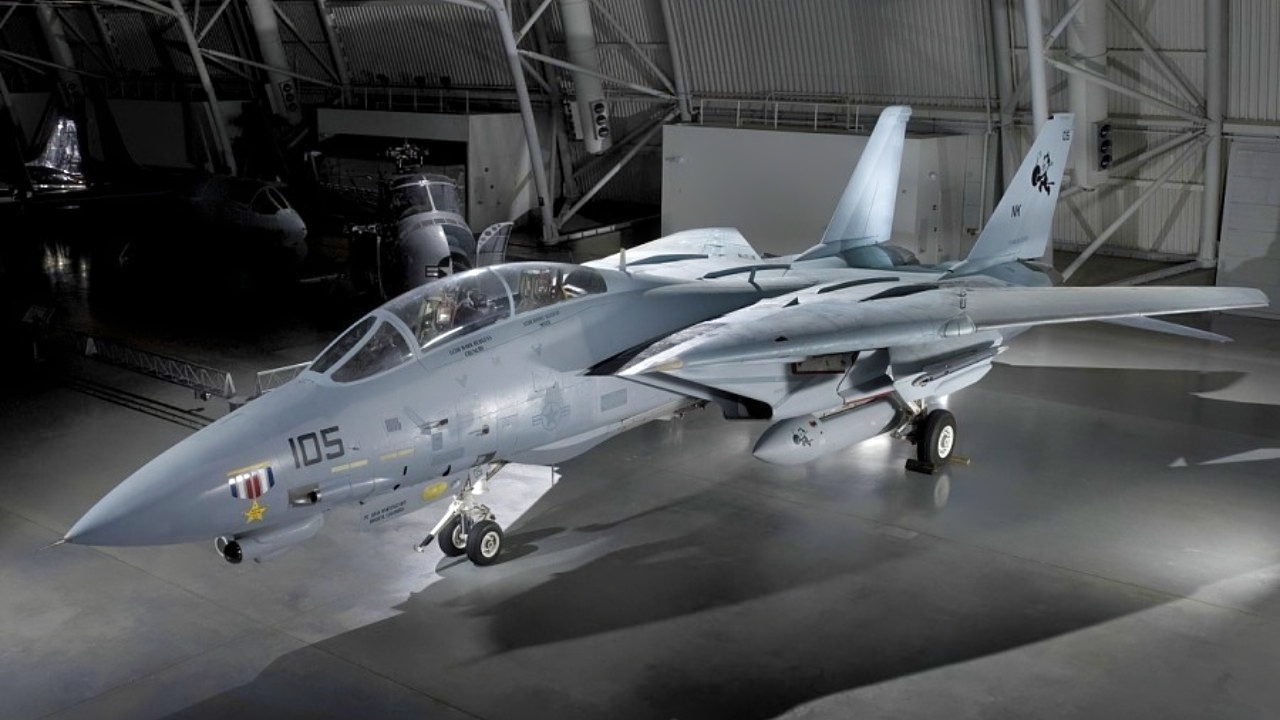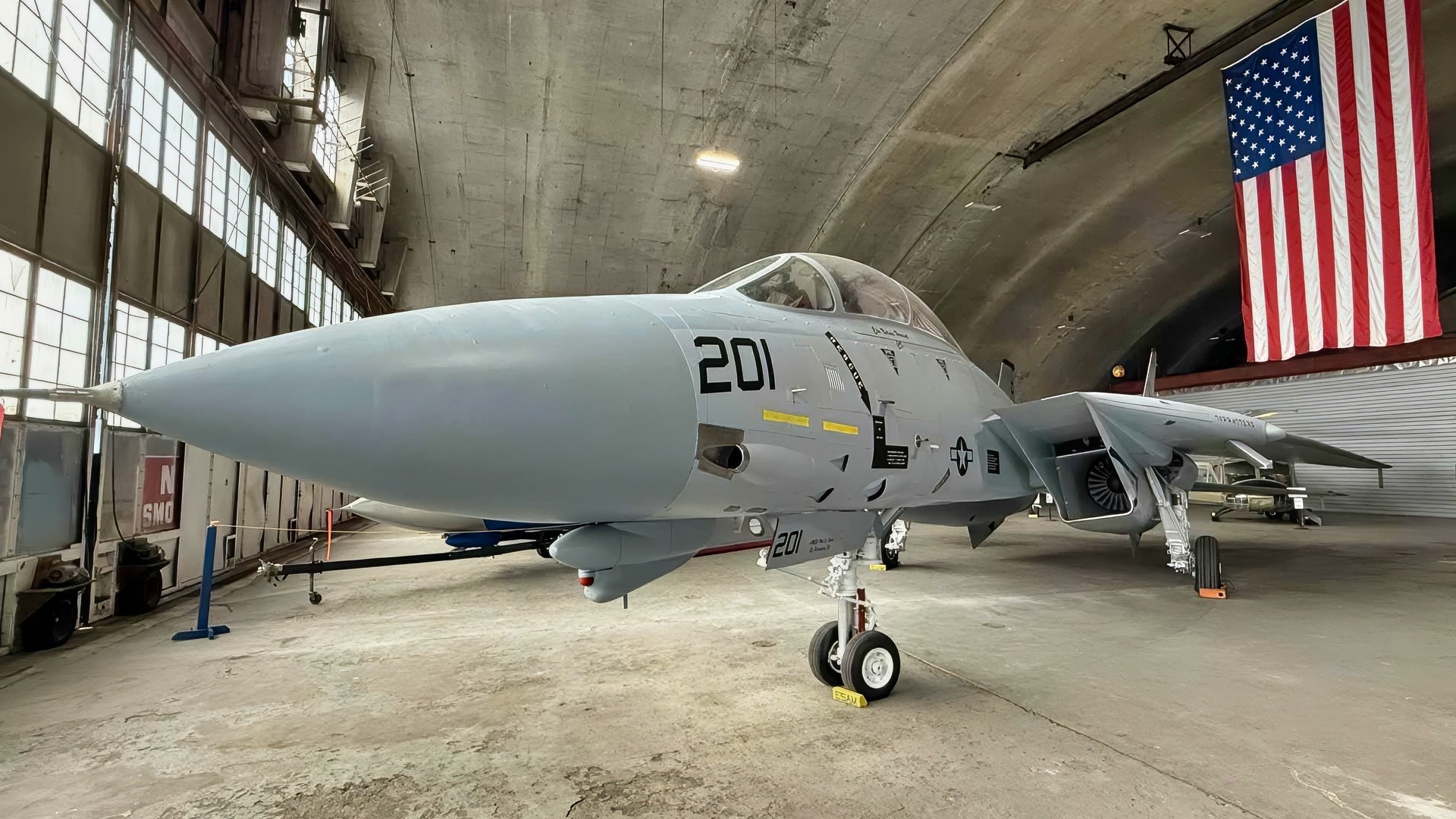Key Points and Summary – The F-14 Tomcat was the U.S. Navy’s premier fleet defense interceptor, designed to protect carriers from Soviet bombers.
-Its key advantages included exceptional range, speed, and endurance, enabled by powerful twin engines and innovative variable-sweep wings that optimized flight across different profiles.

F-14 Tomcat Fighter. Image Credit: Creative Commons.

F-14 Tomcat Museum Photo. Image Credit: Creative Commons.
-Its advanced AWG-9 radar, coupled with the long-range AIM-54 Phoenix missile, provided an unparalleled ability to track up to 24 targets and engage six simultaneously from 100 miles away, pioneering beyond-visual-range combat.
-The two-person crew (pilot and Radar Intercept Officer) further enhanced situational awareness in complex engagements.
The F-14 Tomcat Fighter Is a Legend for Many Reasons
It isn’t easy to quantify the F-14 Tomcat’s significance during its time in the United States Navy.
The jet, tasked with protecting its own aircraft carrier and accompanying warships, as well as prosecuting strike missions against other aircraft and warships.
As an interceptor and fleet defense platform, the F-14 Tomcat was charged with seeking out and shooting down adversarial aircraft. Propelled by a robust pair of high-thrust engines, the F-14’s ability to quickly reach altitude — and remain on station for extended periods of time — was almost unparalleled at the time of their entry into service with the United States Navy.
The jets benefited greatly from a potent radar and air-to-air missile combination.
The AIM-54 Phoenix missile (which replaced the older AIM-7 Sparrow and AIM-9 Sidewinder missiles) and the Tomcat’s AWG-9 radar gave the jet an ability to engage multiple moving targets at extreme ranges.

F-14D Tomcat Onboard USS Intrepid in NYC. Image Taken by National Security Journal on 9/19/2025.
Depending on altitude, flight conditions, and other factors, the Navy’s Tomcats could engage enemy aircraft at about 100 miles (160 kilometers) distant, giving the jet a reach beyond that of its contemporaries.
But not only could the F-14 see deep into contested airspace and shoot down adversary aircraft at the extreme long range of what was then possible — the Tomcat had many eyes, too. The F-14 could track up to two dozen targets simultaneously, and of those 24aircraft could engage six at once.
The F-14 Tomcat was, in essence, optimized to fly against the kinds of large, massed Soviet air formations the U.S. Navy anticipated fighting.
Flight Optimization: Variable-sweep Wing Geometry
The Tomcat could adjust its aerodynamics while in flight for optimization across a variety of flight profiles: low-speed landings, high-speed interceptions and dogfighting, and efficient cruising for longer time on-station — all made possible by the Tomcat’s variable-sweep wings that hinged atop the fuselage, forming a pair of ‘shoulders’ alongside the aircraft’s spine.
This diversity of wing sweep angles allowed the jet to be a remarkably efficient flier, despite sporting a pair of powerful jet engines.
Notably, the F-14’s replacement, the F/A-18 Hornet, along with its more advanced sibling, the outwardly similar F/A-18 Super Hornet, and the F-35 stealth fighter, lack the range of their Cold War-era counterparts.
Zoom Zoom
The F-14’s jet engines, initially Pratt & Whitney TF30s and later upgraded to GE F110S in the F-14B/D, provided a significant advantage over single-engined fighters of the era like the F-16 Fighting Falcon.
Indeed, in operations on aircraft carriers, where an engine failure could be catastrophic for the pilots, flight deck personnel, and the ship itself, this was a distinct advantage.
Especially after the Tomcat’s up-engineing, the jet had exceptional thrust-to-weight ratios, with climb and acceleration profiles that were similar to or, in some cases, superior to those of the F-15.
I See You
The Tomcat’s AWG-9 radar was multiple decades ahead of many contemporaries. It gave the jet a look-down/shoot-down capability — distinguishing low-flying aircraft from ground clutter — which was a growing but still early fighter capability.

F-14 Tomcat Photo Taken on August 24 2025. Image Credit: Jack Buckby/National Security Journal.
This made the Tomcat one of the more significant of the early pioneers of beyond-visual-range aerial combat theory.
Situational Awareness
In the pre-digital era, the combination of a pilot and a Radar Intercept Officer, or RIO, gave the Tomcat task-division assets. Situational awareness, consequently, was enhanced by this arrangement compared to a single-pilot aircraft.
In complex, multiple-adversary situations and long-range interception, this division of labor was a significant advantage, particularly for fleet defense.
The F-14 Tomcat Legacy
In summary, the F-14 Tomcat’s operational advantage lay in its unique ability to reach far-distant points quickly and remain there for long periods of time.
The jet’s exceptionally long radar reach, combined with some of the era’s more long-range air-to-air missiles — and the ability to see and engage aircraft down below — made each Tomcat one eye in a web of deep vision.
The jet’s adaptability and sophisticated sensor suite combine to give it a unique blend of desirable capabilities that few other fighters could match.
Until the advent of fifth-generation aircraft that incorporate technologies foreign to the F-14, the Tomcat ruled the roost.
About the Author: Caleb Larson
Caleb Larson is an American multiformat journalist based in Berlin, Germany. His work covers the intersection of conflict and society, focusing on American foreign policy and European security. He has reported from Germany, Russia, and the United States. Most recently, he covered the war in Ukraine, reporting extensively on the war’s shifting battle lines from Donbas and writing on the war’s civilian and humanitarian toll. Previously, he worked as a Defense Reporter for POLITICO Europe. You can follow his latest work on X.
More Military
Montana-Class: The U.S. Navy’s Superbattleships That Never Sailed
The F-35 Stealth Fighter Feels Like a Black Hole of Trouble
Russia’s Admiral Nakhimov Kirov-Class Battlecruiser Has a Warning for the Russian Navy
China’s Yuan-Class AIP Stealth Submarine Has A Warning for the U.S. Navy
Mach 6 SR-72 Darkstar Could Soon Be the ‘Fastest Plane on Earth’










